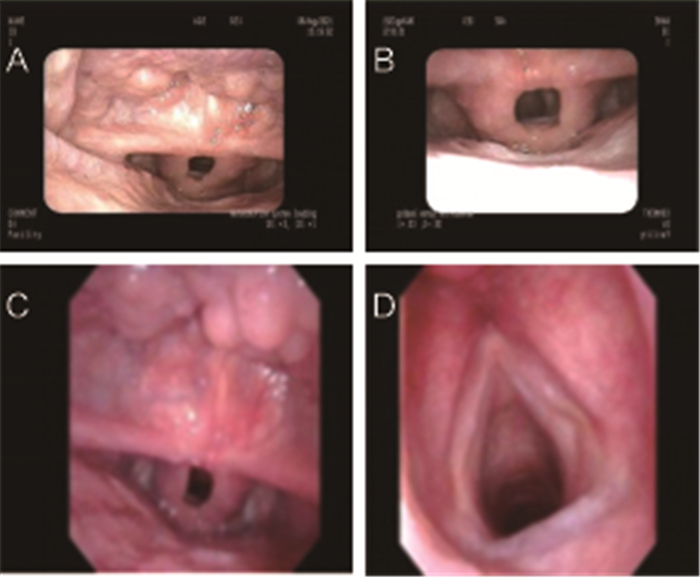2. 济宁医学院附属医院, 济宁 272029
2. Affiliated Hospital of Jining Medical University, Jining 272029, China
非典型类癌罕见于喉部、会厌,是一组症状非特异性、临床诊断和预后不确定的疾病。喉部神经内分泌癌仅占喉部肿瘤的0.6%[1]。喉神经内分泌癌(NECS)是一种罕见的肿瘤(占喉肿瘤的1%以下),主要发生在声门上喉部。有3种亚型:典型类癌、非典型类癌和小细胞非典型类癌[2-3]。
据报道,神经内分泌肿瘤的发病率大约为每年7/1000万,占所有肿瘤的3%,但却很少发生于喉部[4]。喉非典型类癌的真实发病率尚不清楚,男女比例为3∶1,平均发病年龄为60岁,通常好发于重度吸烟者。90%以上发生在会厌皱襞、杓状突或室索附近[5],但也有发生于悬雍垂,鼻咽部等部位[6]。常见症状为呼吸困难,吞咽困难,声音嘶哑。由于非典型类癌转移率极高,具有高度侵袭性,可能发生转移(5年生存率为48%),在常规手术的基础上应建议行放射治疗,而非单纯手术治疗[7]。
1 病例报告一男性60岁,有30年的吸烟和饮酒史,身高160cm,体重75kg,血压127/71mmHg。由于咽喉部不适1年入院,伴有疼痛及异物感,吞咽时明显。电子喉镜示会厌喉面偏右侧可见淡蓝色隆起,会厌谷偏右侧可见表面呈桑葚样隆起(图 1a)。喉部MRI平扫+增强扫描+弥散加权成像见会厌右缘-右侧杓状会厌壁可见不规则结节,大小约9mm×10mm×14mm, 边缘呈乳头状,边界清楚。喉腔不窄,无增厚。双侧颈动脉鞘区,颌下区见多发略增大淋巴结。

|
图 1 患者术前检查结果 注:A.术前电子喉镜检查结果;B.病理结果;C.免疫组化染色。 |
入院后患者于全麻下经口下支撑喉镜行支撑喉镜下会厌肿物切除术,将会厌喉面暗红色肿物以电钩切除送检快速病理,结果示会厌恶性肿瘤,告知患者家属病理结果后,该家属拒绝继续手术。2020-11-26常规病理学报告示石蜡切片:冰冻送检(会厌)神经内分泌肿瘤,结合免疫组化倾向于非典型类癌:免疫组化:CK(+),LCA(-),Ki-67(+5%~10%),HMB-45(-),S-100(-), P63(-), CgA(+), NSE(-),Syn(+),CD38(-)(图 1B/C)。
患者及家属经过商议决定再次手术,于2020-11-28再次入院。骨显像示胸腰椎多个椎体核素分布不均,边缘核素浓聚,双侧肩,肘,腕,掌指及指尖,膝,踝关节核素较浓聚,其余所显像的骨质未见明显异常。
遂于11月30日在我院行功能性颈部淋巴结清扫术及会厌切除术,会厌右缘-右侧杓状会厌壁肿物大小约9mm×10mm×14mm。后行双侧颈部Ⅰ、Ⅱ、Ⅳ、Ⅴ、Ⅵ区颈部淋巴结清扫术,清除上述区城淋巴结脂肪组织。左侧颈部Ⅱ、Ⅲ区及右侧颈部Ⅱ、Ⅲ、Ⅳ区见肿大淋巴结。术后出院并定期接受随访。患者及家属拒绝行放化疗。患者术后定期复查,至今,恢复良好,无复发。见图 2。

|
图 2 某患者电子喉镜复查结果 注:A/B术后9个月, C/D术后14个月电子喉镜复查结果。 |
喉非典型类癌患者预后不良,影响预后的因素包括Ki-67、肿瘤的大小、转移等[7-8]。
虽然许多喉部恶性肿瘤与HPV感染有关,但喉部非典型类癌的发生与HPV无关[9]。国外学者研究了26年内20例喉神经内分泌肿瘤患者,发现大多数患者为男性(15,75%),有长期吸烟史(15,75%)[10]。非典型类癌的发生与p53基因突变有关[11]。Chung等[12]于2004年发现6例中分化喉癌患者中有3例p53阳性。McCluggage等[13]于1997年也同样报道了3例非典型喉癌p53阳性。Overholt等[14]1995年发现了8例喉神经内分泌肿瘤中有2例非典型类癌,其中6例p53阳性。但关于p53基因突变与会厌非典型的预后仍有待进一步研究。
约于1969年喉神经内分泌肿瘤被首次报道[15]。Ki-67被认为是最常用的预后生物标志物和网络分类的基础[16],可以较好地反映恶性肿瘤的增殖状态,可能与肿瘤术后复发有关。该案例中免疫组化结果显示,肿瘤标本热点区域仅有5%~10%的细胞为Ki-67阳性。根据一项meta分析结果显示,典型类癌、不典型类癌5年生存率分别为100%、53%[8]。根据国外学者研究,与典型类癌相比,非典型类癌患者更容易发生远处转移(42.0%对57.1%)[17],两者形成鲜明对比。Soga于2003年分析了11842例类癌和变异类癌,发现199例喉非典型类癌,转移率为66.8%[18]。
非典型类癌的大小是一个重要的预后因素,>1cm的原发肿瘤的死亡率是≤1cm的两倍(44%对23%)[17]。该案例中会厌右缘-右侧杓状会厌壁肿物约9mm×10mm×14mm,该案例中非典型类癌≥1cm,根据术后近2年的随访,目前患者情况良好,未见复发。对于局限性肿瘤,可选择CO2激光单纯切除肿瘤代替颈部清扫术,但对于较大的肿瘤,应扩大手术范围。大多数会厌非典型类癌患者复发可能发生在5年随访期之后,所以我们最好将术后随访期延长到10年[19]。因此,患者术后仍需密切随访。
会厌非典型类癌与典型类癌相比有一突出特点,会厌非典型类癌病程常呈现侵袭性。对于非典型类癌的诊断并不十分简单,尤其是在其最初的活检评估中,但此活检评估却对治疗的选择十分重要。通常为黏膜下肿块,并没有明显溃疡,第一、表型上,肿瘤细胞呈均匀的多角形,核质比高,排列成巢状、索状或假腺体。细胞质一般为嗜酸性,细胞核为中心、圆形、细粒染色质和不明显的核仁。可呈巢状、带状、小梁状、条纹状、腺泡状或假腺状生长。第二、免疫组化染色对于区分非典型类癌与其他上皮性恶性肿瘤,包括甲状腺髓样癌非常重要[20]。病理分类对于会厌神经内分泌肿瘤的正确治疗指导非常重要,这是由于神经内分泌肿瘤的行为因亚型而不同。
有学者认为放疗对晚期非典型类癌无效,手术是会厌非典型类癌唯一有效的治疗方法。放射治疗会厌非典型类癌仍存在争议。有人建议,当完全切除困难且手术无效时,应在术后给予放疗和化疗作为辅助治疗[21]。美国一项多中心研究表明,放疗与其他方法相结合对于局部晚期或者是转移性肺癌有价值[22]。接受术后放射治疗的患者DSS(疾病的特异性生存期)表现较差,即手术效果优于放疗,术后放疗不一定能获益[23]。大多数学者的观点,该患者宜行放化疗。该患者拒绝放化疗后,复查至今,未见复发,因而还需更多病例证实放化疗在非典型类癌治疗中的作用。考虑到颈部淋巴结转移和隐匿性转移的高可能性,即使在N0病例中也应进行选择性双侧颈部淋巴结清扫(Ⅱ~Ⅳ节段与Ⅱa~Ⅲ节段)[24]。临床医生在检查淋巴结或不明原发灶的皮肤转移时,应怀疑会厌肿瘤转移[25]。该案例我们采用支撑喉镜下会厌切除及颈部淋巴结清扫,而未行气管切开,取得了良好效果,该术式较常规术式,创伤更小,恢复更快。
简而言之,对于治疗顽固性癌症,分子靶向治疗已被证明能显著改善乳腺癌、肺癌和结肠癌的预后。由于会厌非典型类癌的高远处转移率,我们不免会联想到运用分子靶向疗法来治疗会厌非典型类癌。靶向治疗的主要类别是小分子和单克隆抗体。有外国学者研究发现非典型类癌具有用于分子靶向治疗的特异性蛋白表达。免疫组化分析肿瘤元件显示PDGFRa、VEGFR2和EGFR呈强阳性,在70%的病例中发现PDGF表达[26]。然而,这些蛋白的表达以及分子靶向治疗非典型类癌的临床应用有待进一步研究。
利益冲突:所有作者均申明不存在利益冲突。
| [1] |
Wenig BM, Hyams VJ, Heffner DK. Moderately differentiated neuroendocrine carcinoma of the larynx.A clinicopathologic study of 54 cases[J]. Cancer, 1988, 62(12): 2658-2676. DOI:10.1002/1097-0142(19881215)62:12<2658::AID-CNCR2820621235>3.0.CO;2-M |
| [2] |
Bapat U, Mackinnon NA, Spencer MG. Carcinoid tumours of the larynx[J]. Eur Arch Otorhinolaryngol, 2005, 262(3): 194-197. DOI:10.1007/s00405-004-0788-y |
| [3] |
Gillenwater A, Lewin J, Roberts D, et al. Moderately differentiated neuroendocrine carcinoma (atypical carcinoid) of the larynx: A clinically aggressive tumor[J]. Laryngoscope, 2005, 115(7): 1191-1195. DOI:10.1097/01.MLG.0000166179.40750.1B |
| [4] |
Bray F, Ferlay J, Soerjomataram I, et al. Global cancer statistics 2018:GLOBOCAN estimates of incidence and mortality worldwide for 36 cancers in 185 countries[J]. CA Cancer J Clin, 2018, 68(6): 394-424. DOI:10.3322/caac.21492 |
| [5] |
Barnes L, Eveson J, Reichart P, et al. World health organization classification of tumours: Pathology and genetics of head and neck tumours[J]. IARC Press, 2005, 135-139. |
| [6] |
Goldman NC, Barnes RE. Atypical carcinoid (moderately differentiated neuroendocrine carcinoma) of the uvula[J]. Ear Nose Throat J, 2012, 91(2): 75-76. DOI:10.1177/014556131209100211 |
| [7] |
Batsakis JG, Luna MA, Byers RM. Metastases to the larynx[J]. Head Neck Surg, 1985, 7(6): 458-460. DOI:10.1002/hed.2890070604 |
| [8] |
van der Laan TP, Plaat BE, van der Laan BF, et al. Clinical recommendations on the treatment of neuroendocrine carcinoma of the larynx: A meta-analysis of 436 reported cases[J]. Head Neck, 2015, 37(5): 707-715. DOI:10.1002/hed.23666 |
| [9] |
Torrente MC, Ampuero S, Abud M, et al. Molecular detection and typing of human papilloma virus in laryngeal carcinoma[J]. Acta Otolaryngol, 2005, 125(8): 888-893. DOI:10.1080/00016480510038220 |
| [10] |
Primož S, Robert Š, Alfio F, et al. Neuroendocrine carcinoma of the larynx and pharynx: A clinical and histopathological study[J]. Cancers, 2021, 13(19). DOI:10.3390/cancers13194813 |
| [11] |
Giordano G, Corcione L, Giordano D, et al. Primary moderately differentiated neuroendocrine carcinoma (atypical carcinoid) of the larynx: A case report with immunohistochemical and molecular study[J]. Auris Nasus Larynx, 2009, 36(2): 228-231. DOI:10.1016/j.anl.2008.05.002 |
| [12] |
Chung JH, Lee SS, Shim YS, et al. A study of moderately differentiated neuroendocrine carcinomas of the larynx and an examination of non-neoplastic larynx tissue for neuroendocrine cells[J]. Laryngoscope, 2004, 114(7): 1264-1270. DOI:10.1097/00005537-200407000-00023 |
| [13] |
McCluggage WG, Cameron CH, Arthur K, et al. Atypical carcinoid tumor of the larynx: an immunohistochemical, ultrastructural, and flow cytometric analysis[J]. Ultrastruct Pathol, 1997, 21(5): 431-438. DOI:10.3109/01913129709021942 |
| [14] |
Overholt SM, Donovan DT, Schwartz MR, et al. Neuroendocrine neoplasms of the larynx[J]. Laryngoscope, 1995, 105(8 Pt 1): 789-794. DOI:10.1288/00005537-199508000-00004 |
| [15] |
Goldman NC, Hood CI, Singleton GT. Carcinoid of the larynx[J]. Arch Otolaryngol, 1969, 90(1): 64-67. DOI:10.1001/archotol.1969.00770030066013 |
| [16] |
Bräutigam K, Rodriguez-Calero A, Kim-Fuchs C, et al. Update on histological reporting changes in neuroendocrine neoplasms[J]. Curr Oncol Rep, 2021, 23(6): 65. DOI:10.1007/s11912-021-01062-6 |
| [17] |
Babin E, Rouleau V, Vedrine PO, et al. Small cell neuroendocrine carcinoma of the nasal cavity and paranasal sinuses[J]. J Laryngol Otol, 2006, 120(4): 289-297. DOI:10.1017/S0022215106000594 |
| [18] |
Soga J. Carcinoids and their variant endocrinomas. An analysis of 11842 reported cases[J]. J Exp Clin Cancer Res, 2003, 22(4): 517-530. |
| [19] |
Angouridakis N, Goudakos J, Karayannopoulou G, et al. Primary neuroendocrine neoplasms of the larynx.A series of 4 cases reported and a review of the literature[J]. Head Neck, 2013, 35(6): E187-E193. DOI:10.1002/hed.22955 |
| [20] |
el-Naggar AK, Batsakis JG, Vassilopoulou-Sellin R, et al. Medullary (thyroid) carcinoma-like carcinoids of the larynx[J]. J Laryngol Otol, 1991, 105(8): 683-686. DOI:10.1017/s0022215100117037 |
| [21] |
Furuta A, Kudo M, Kanai KI, et al. Typical carcinoid tumor arising in the nose and paranasal sinuses-case report[J]. Auris Nasus Larynx, 2010, 37(3): 381-385. DOI:10.1016/j.anl.2009.09.007 |
| [22] |
Dasari A, Bergsland EK, Benson AB, et al. Treatment patterns and clinical outcomes in advanced lung neuroendocrine tumors in real-world settings: A multicenter retrospective chart review study[J]. Oncologist, 2019, 24(8): 1066-1075. DOI:10.1634/theoncologist.2018-0520 |
| [23] |
Ferlito A, Lewis JS, Rinaldo A. The evolving management of laryngeal neuroendocrine carcinomas[J]. Eur Arch Otorhinolaryngol, 2011, 268(9): 1247-1248. DOI:10.1007/s00405-011-1666-z |
| [24] |
Wang Q, Chen H, Zhou S. Typical laryngeal carcinoid tumor with recurrence and lymph node metastasis: a case report and review of the literature[J]. Int J Clin Exp Pathol, 2014, 7(12): 9028-9031. |
| [25] |
Duan K, Mete O. Algorithmic approach to neuroendocrine tumors in targeted biopsies: Practical applications of immunohistochemical markers[J]. Cancer Cytopathol, 2016, 124(12): 871-884. DOI:10.1002/cncy.21765 |
| [26] |
Kanazawa T, Nokubi M, Takeoda K, et al. Atypical carcinoid of the larynx and expressions of proteins associated with molecular targeted therapy[J]. Auris Nasus Larynx, 2011, 38(1): 123-126. DOI:10.1016/j.anl.2010.05.008 |



